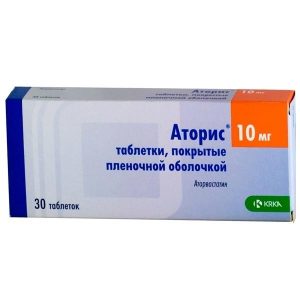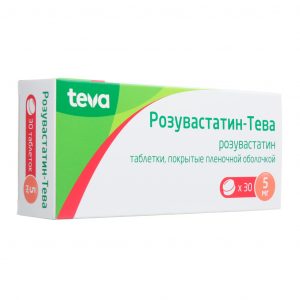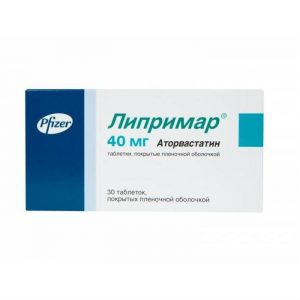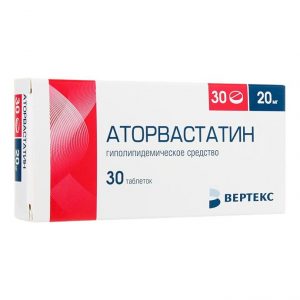Description
Pharmacological action of
ATX code: C10AB05
Pharmacological properties of
Pharmacodynamics
Activating RAPP-alpha (peroxis proliferator-activated alpha receptors), fenofibrate enhances plasma lipolysis and excretion of atherogenic lipoproteins with a high content of triglycerides by activating lipoprotein lipase and reducing synthesis of SS apoprotein. Activation of RAPP-alpha also leads to increased synthesis of apoproteins AI and AN.
Fenofibrate is a derivative of fibroic acid, the ability of which to change the lipid content in the human body is mediated by the activation of RAPP-alpha. The effects of fenofibrate on lipoproteins described above lead to a decrease in the content of the low lipoprotein fraction (LDL) and very low density (VLDL), which include apoprotein B, and an increase in the content of the high density lipoprotein fraction (HDL), which include apoproteins AI and AN .
In addition, due to the correction of violations of the synthesis and catabolism of VLDL, fenofibrate increases the clearance of LDL and reduces the content of dense and small particle size of LDL, an increase which is observed in patients with an atherogenic lipid phenotype, a frequent violation in patients at risk of coronary heart disease.
In clinical studies, it was noted that the use of fenofibrate reduces total cholesterol by 20 – 25% and triglycerides by 40 – 55% with an increase in HDL cholesterol by 10 – 30%. In patients with hypercholesterolemia, in which the LDL-cholesterol level is reduced by 20 – 35%, the use of fenofibrate led to a decrease in the ratios: “total cholesterol / HDL-cholesterol”, “LDL-cholesterol / HDL-cholesterol” and “Apo B / Apo AI” being markers of atherogenic risk.
Given the effect of fenofibrate on LDL cholesterol and triglycerides, the use of the drug is effective in patients with hypercholesterolemia, both accompanied and not accompanied by hypertriglyceridemia, including secondary hyperlipoproteinemia, for example, with type 2 diabetes mellitus.
During treatment with fenofibrate, extravascular deposits of cholesterol (tendon and tuberous xanthomas) can significantly decrease and even completely disappear. In patients with elevated fibrinogen levels who received fenofibrate treatment, a significant decrease in this indicator was noted, as well as in patients with elevated lipoprotein levels. Other markers of inflammation, such as C-reactive protein, also decrease with fenofibrate treatment.
For patients with dyslipidemia and hyperuricemia, the added benefit is the uricosuric effect of fenofibrate, leading to a decrease in the concentration of uric acid by approximately 25%. In clinical studies and in animal experiments, fenofibrate has been shown to reduce platelet aggregation caused by adenosine diphosphate, arachidonic acid, and epinephrine.
Pharmacokinetics
Tricor 145 mg film-coated tablets contain 145 mg nanoparticle micronized fenofibrate. The initial plasma fenofibrate is not detected. The main plasma metabolite is fenofibroic acid.
Absorption: maximum plasma concentration (Cmax) is reached 2-4 hours after ingestion. With prolonged use, the plasma concentration of the drug remains stable, regardless of the individual characteristics of the patient. Unlike previous dosage forms of fenofibrate, the maximum concentration in plasma and the total effect of fenofibrate in the form of nanoparticles is independent of food intake. Therefore, Tricor 145 mg can be taken at any time, regardless of food intake.
Distribution: fenofibroic acid binds strongly to plasma albumin (more than 99%).
Half-life: The half-life of fenofibroic acid (T1 / 2) is about 20 hours.
Metabolism and excretion: after oral administration, fenofibrate is rapidly hydrolyzed by esterases. Only the main active metabolite of fenofibrate, fenofibroic acid, is found in plasma. Fenofibrate is not a substrate for CYP 3A4. It does not participate in microsomal metabolism.
Excreted mainly in urine as fenofibroic acid and glucuronide conjugate. Within 6 days, fenofibrate is excreted almost completely. The total clearance of fenofibroic acid, determined in elderly patients, does not change.
The drug does not cumulate after a single dose and with prolonged use. With hemodialysis, not inwithdrawn.
Indications
Hypercholesterolemia and hypertriglyceridemia isolated or mixed (dyslipidemia type IIa, IIb, III, IV, V) in patients for whom diet or other non-pharmacological treatment measures (for example, weight loss or increased physical activity) were ineffective, especially with the presence of dyslipidemia-related risk factors such as arterial hypertension and smoking.
For the treatment of secondary hyperlipoproteinemia, the drug is used in cases where hyperlipoproteinemia persists despite the effective treatment of the underlying disease (for example, dyslipidemia in diabetes mellitus).
Contraindications
The drug is strictly contraindicated in the following cases:
hypersensitivity to fenofibrate or other components of the drug,
liver failure (including cirrhosis),
severe renal failure (creatinine clearance under 18 years of age (efficacy and safety not established),
history of photosensitization or phototoxicity with ketoprofen,
gallbladder disease,
breastfeeding period,
congenital galactosemia, lactase deficiency, malabsorption of glucose and galactose (preparation t contains lactose),
congenital fruktozemiya, sucrase-isomaltase deficiency (preparation contains sucrose),
allergic to peanuts, peanut oil, soy lecithin or a history of related products (due to the risk of hypersensitivity reaction).
With caution
for liver and / or renal failure, hypothyroidism in elderly patients with alcohol abuse, with a history of hereditary muscle diseases while taking oral anticoagulants, HMG-CoA reductase inhibitors (see section Drug Interactions “).
Special instructions
Before starting treatment with Trikor 145 mg, appropriate treatment should be carried out to eliminate the cause of secondary hypercholesterolemia, for example, in diseases such as uncontrolled type 2 diabetes, hypothyroidism, nephrotic syndrome, dysproteinemia, obstructive liver disease, consequences drug therapy, alcoholism.
The effectiveness of therapy should be evaluated by the content of lipids (total cholesterol, LDL, triglycerides) in the blood serum. In the absence of a therapeutic effect after several months of therapy (usually after 3 months), the feasibility of prescribing concomitant or alternative therapy should be considered.
In patients with hyperlipidemia taking estrogens or hormonal contraceptives containing estrogens, it is necessary to find out whether hyperlipidemia is of primary or secondary nature. In such cases, an increase in lipid levels can be caused by
estrogen intake. Liver function: When taking Tricor 145 mg and other lipid-lowering drugs, an increase in hepatic transaminases is described in some patients. In most cases, this increase was temporary, minor and asymptomatic. During the first 12 months of treatment, it is recommended to monitor the level of transaminases (ALT, ACT) every 3 months. Patients who have increased transaminase concentrations during treatment need attention, and if the concentration of ALT and ACT is more than 3 times higher than the upper limit of the norm, the drug is stopped.
Pancreatitis: Cases of pancreatitis have been described during treatment with Triicor 145 mg. Possible causes of pancreatitis in these cases were: insufficient drug efficacy in patients with severe hypertriglyceridemia, direct exposure to the drug, as well as secondary phenomena associated with the presence of stones or the formation of sediment in the gallbladder, accompanied by obstruction of the common bile duct.
Muscles: When taking Tricor 145 mg and other drugs that lower lipid concentrations, there have been cases of toxic effects on muscle tissue, including very rare cases of rhabdomyolysis. The frequency of such a disorder increases in the case of hypoalbuminemia and a history of renal failure.
Toxic effects on muscle tissue may be suspected based on patient complaints of weakness, diffuse myalgia, myositis, muscle cramps and cramps and / or a marked increase in creatinine phosphokinase (CPK) (more than 5 times compared with the upper limit of normal). In these cases, treatment with TRICOR 145 mg must be discontinued.
The risk of developing rhabdomyolysis may increase in patients with a predisposition to myopathy and / or rhabdomyolysis, including age over 70, a history of hereditary muscle diseases, impaired renal function, hypothyroidism, and alcohol abuse. Such patients should be prescribed the drug only if the expected benefit exceeds the possible risk of rhabdomyolysis. When taking Traicor 145 mg at the same time as HMG-CoA reductase inhibitors or other fibrates, the risk of serious toxic effects on muscle fibers is increased, especially if the patient had muscle disease before treatment. In this regard, the combined administration of Tricor 145 mg and statin is permissible only if the patient has severe mixed dyslipidemia and high cardiovascular risk, in the absence of a history of muscle disease and under close monitoring aimed at identifying signs of the development of toxic effects on muscle tissue .
Renal function: In the case of an increase in creatinine concentration more than 50% above the upper limit of normal treatment should be stopped. In the first three months of treatment, creatinine concentrations are recommended.
Influence on the ability to drive a car and other mechanisms
When using the drug, there was no effect on the ability to drive a car and control mechanisms.
Composition
Active ingredient:
Fenofibrate (micronized) 145.0 mg
Auxiliary substances:
Sucrose 145.0 mg
Sodium 10 lauryl 2 mg
Lactose monohydrate 132.0 mg
Crospovidone 75.5 mg
Microcrystalline cellulose 84.28 mg
Silicon colloidal dioxide 1.72 mg
Hypromellose 29.0 mg
Docusate sodium 2.9 mg
Magnesium
Shell (OpadriВ® OY-B-28920): 25.1 mg
Polyvinyl alcohol 11.43 mg
Titanium wild Id
8.03 mg Talc 5.02 mg Soy Lecithin
0.50 mg 0.12 mg Xanthan gum
Dosage and administration
Tricoror tablets 145 mg should be swallowed whole without chewing, washed down with water. Tricor 145 mg can be taken at any time of the day, regardless of food intake.
Adults. One tablet of Traicor 145 mg once a day.
Patients who take one 200 mg fenofibrate capsule or one 160 mg fenofibrate tablet per day may switch to taking 1 tablet of Traicor 145 mg without additional dose adjustment.
Elderly patients. It is recommended to take a standard dose for adults (one tablet of Tricor 145 mg once a day).
Patients with liver disease. The use of the drug in patients with liver diseases has not been studied.
The drug should be taken for a long time, while continuing to follow a diet, which the patient adhered to before starting treatment with Tricor 145 mg.
Side effects of
From the gastrointestinal tract:> 1/100,> 1/1000,
From the liver:> 1/100,> 1/1000,
From the musculoskeletal system and connective tissue:> 1 / 10000,
Vascular disorders:> 1/1000,
From the circulatory and lymphatic systems:> 1/10000,
From the nervous system:> 1/10000,
From the respiratory system:
From the skin and subcutaneous fat fiber:> 1/1000,> 1/10000,
Laboratory tests:> 1/1000,
Overdose
Cases of overdose are not described. The specific antidote is unknown. If an overdose is suspected, symptomatic and, if necessary, supportive treatment should be prescribed. Hemodialysis is ineffective.
Terms of delivery from
pharmacies Prescription
Dosage form
tablets




